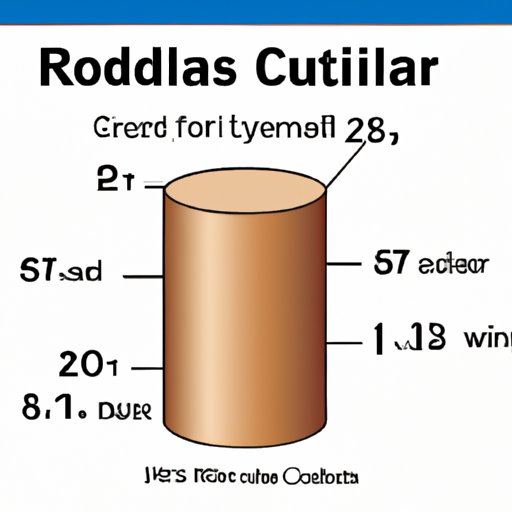
Introduction
A cylinder is a three-dimensional shape that has two circular bases connected by a curved surface. It is a common shape in many real-world applications, and knowing how to calculate its volume is important for professionals and hobbyists alike. In this article, we will explore step-by-step instructions for calculating the volume of a cylinder, real-world applications of these calculations, comparing different methods for calculating cylinder volume, and visual aids to assist in understanding. We will also highlight common mistakes and provide tips and exercises for improving your skills.
Step-by-Step Guide to Calculating Cylinder Volume
The formula for calculating the volume of a cylinder is:
Volume of a cylinder = π x r^2 x h or Volume of a cylinder = π x (d/2)^2 x h
where r is the radius, h is the height, and d is the diameter.
To calculate the volume of a cylinder using radius and height, follow these steps:
- Determine the radius (r) and height (h) of the cylinder.
- Square the radius (r) and multiply by π (pi).
- Multiply the result by the height (h) of the cylinder.
- The final answer is the volume of the cylinder in cubic units.
For example, if a cylinder has a radius of 5 cm and a height of 10 cm:
Volume = π x (5 cm)^2 x 10 cm = 785.4 cubic cm.
To calculate the volume of a cylinder using diameter and height, follow these steps:
- Determine the diameter (d) and height (h) of the cylinder.
- Square the radius (r) and multiply by π (pi).
- Multiply the result by the height (h) of the cylinder.
- The final answer is the volume of the cylinder in cubic units.
For example, if a cylinder has a diameter of 10 cm and a height of 15 cm:
Volume = π x (10 cm/2)^2 x 15 cm = 589.05 cubic cm.
Common units of measurement for volume include cubic centimeters, cubic inches, cubic meters, and liters.
Real-World Applications of Cylinder Volume Calculation
Cylinder volume calculations are useful in a variety of fields, including construction, engineering, and manufacturing.
Construction professionals use cylinder volume calculations for pouring concrete, determining the amount of liquid needed to fill a cylindrical pipe or tank, and designing cylindrical structures.
Engineers use cylinder volume calculations for fluid dynamics, temperature control, and designing cylinders for pressure vessels.
Manufacturers use cylinder volume calculations for sizing tanks, designing packaging for cylindrical products, and calculating the amount of material needed to manufacture a cylindrical product.
Comparing Cylinder Volume Calculation Methods
There are three methods for calculating the volume of a cylinder – the radius method, the diameter method, and the height method.
The radius method involves squaring the radius and multiplying by pi, and then multiplying the result by the height of the cylinder. The advantage of this method is that it only requires one dimension to be determined. The disadvantage is that it requires squaring the radius, which may not be easy to calculate in some cases.
The diameter method involves calculating the radius from the diameter by dividing by 2, then squaring the radius and multiplying by pi, and then multiplying the result by the height of the cylinder. The advantage of this method is that it only requires one dimension to be determined. The disadvantage is that it requires the extra step of dividing the diameter by 2 to find the radius, which may not be easy to calculate mentally.
The height method involves multiplying the area of the circular base (pi times the radius squared) by the height of the cylinder. The advantage of this method is that it only requires the radius to be determined once. The disadvantage is that it involves finding the area of the circular base, which may not be easy to remember.
Visual Aids for Understanding Cylinder Volume Calculation
2D and 3D diagrams of cylinders with labeled dimensions can be helpful in understanding the formula for calculating the volume of a cylinder. Animated videos demonstrating the calculation methods can also be helpful, especially for visual learners. Interactive web tools that allow users to practice cylinder volume calculations can provide a hands-on approach to learning.
Common Mistakes When Calculating Cylinder Volume
The most common mistakes when calculating cylinder volume include forgetting to use the correct units of measurement, misinterpreting dimensions (such as confusing radius and diameter), and misapplying the volume formula (such as using incorrect values of pi).
Tips and Exercises for Improving Cylinder Volume Calculation Skills
One helpful exercise for improving cylinder volume calculation skills is to practice with different levels of difficulty. Another exercise is to quiz yourself regularly to ensure you are retaining the information. Additional resources such as online forums, study groups, or instructional videos can also be helpful in improving your skills.
Conclusion
Calculating the volume of a cylinder is an important practical skill with real-world applications in construction, engineering, and manufacturing. There are different methods for calculating cylinder volume, each with their own advantages and limitations. Visual aids, such as diagrams and interactive web tools, can help in understanding the formula. Avoiding common mistakes and practicing with different levels of difficulty can help you master this useful skill.




